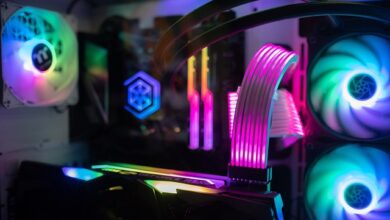
In today’s technology-driven world, computers have become an integral part of our daily lives, whether for work, education, or entertainment. However, like all machines, computers are prone to problems that can disrupt productivity and cause frustration. From slow performance to unexpected crashes, troubleshooting common computer issues is essential knowledge for every user. This comprehensive guide will walk you through the most common computer problems and provide step-by-step solutions to fix them.
Table of Contents:
- Slow Performance
- Blue Screen of Death (BSOD)
- Computer Freezing or Crashing
- Internet Connectivity Issues
- Unresponsive Programs or Applications
- Overheating
- Peripheral Devices Not Working
- Software Installation Issues
- Audio Problems
- Malware and Viruses
1. Slow Performance
A slow computer is one of the most common issues users face. Over time, performance can degrade due to various factors such as unnecessary startup programs, cluttered hard drives, or outdated software.
Causes:
- Too many background processes: Running several programs simultaneously can overburden the system.
- Insufficient RAM: Low memory capacity can slow down operations, especially when running demanding applications.
- Fragmented Hard Drive: On older systems with mechanical hard drives, fragmentation can lead to slower file access times.
- Outdated Software or Drivers: Operating system and driver updates are essential for maintaining performance.
Solutions:
- Disable startup programs: Go to Task Manager (Ctrl+Shift+Esc), navigate to the “Startup” tab, and disable unnecessary programs.
- Upgrade RAM: If your computer is constantly lagging, upgrading your RAM may improve performance significantly.
- Disk Cleanup and Defragmentation: Run Disk Cleanup and Defragmentation tools to clear temporary files and organize fragmented data.
- Update OS and Drivers: Always ensure your operating system and drivers are up to date to optimize performance.
2. Blue Screen of Death (BSOD)
The dreaded “Blue Screen of Death” (BSOD) is a critical error that forces your computer to stop working. This issue often occurs due to hardware problems, corrupted drivers, or software conflicts.
Causes:
- Hardware failures: Problems with RAM, hard drives, or other components.
- Corrupted drivers: Incompatible or outdated drivers can trigger system crashes.
- Software conflicts: Certain applications or system settings may clash, causing a BSOD.
Solutions:
- Check hardware: Use diagnostic tools to check for faulty hardware such as bad RAM or a failing hard drive.
- Update drivers: Ensure all drivers are updated to the latest versions. You can do this manually or through automated driver update tools.
- Restore system settings: If you recently installed new software or made changes to the system, try using System Restore to revert the system to a stable state.
3. Computer Freezing or Crashing
A computer that frequently freezes or crashes can be frustrating, and the causes may vary from overheating to software conflicts.
Causes:
- Overheating: Computers can overheat if the cooling system is malfunctioning or if the computer is placed in a poorly ventilated area.
- Software bugs: Glitches in software can cause crashes.
- Hardware issues: Failing components like the motherboard, RAM, or hard drive can lead to frequent crashes.
Solutions:
- Ensure proper ventilation: Make sure your computer is placed in a well-ventilated area and that its cooling system is functioning properly. Clean out any dust or debris from the fans.
- Check for software updates: Ensure all programs and the operating system are up to date, as updates often include bug fixes.
- Run diagnostics on hardware: Use system tools or third-party applications to check the health of your hardware.
4. Internet Connectivity Issues
Slow or intermittent internet connections can hamper your productivity, especially in a world where much of our work and communication relies on the internet.
Causes:
- Weak Wi-Fi signal: Physical obstructions or distance from the router can weaken the Wi-Fi signal.
- ISP problems: Sometimes, the issue lies with your internet service provider (ISP).
- Incorrect network settings: Misconfigured settings can prevent your device from connecting to the internet.
Solutions:
- Check router and modem: Restart your router and modem to refresh the connection.
- Move closer to the router: If you’re using Wi-Fi, move your device closer to the router or remove obstacles that could be blocking the signal.
- Check ISP status: Contact your ISP to check if there are any outages in your area.
- Reset network settings: Reset your network adapter by going to “Settings” > “Network & Internet” > “Status” > “Network Reset.”
5. Unresponsive Programs or Applications
Applications that freeze or crash can interrupt your workflow and cause data loss.
Causes:
- Insufficient system resources: Lack of memory or CPU power can cause programs to become unresponsive.
- Conflicting software: Certain programs may conflict with each other, leading to freezes.
- Outdated software: Older versions of programs may not run smoothly on updated operating systems.
Solutions:
- Force quit the program: Press Ctrl+Alt+Delete to open Task Manager and force quit the unresponsive application.
- Check system resources: If your CPU or RAM usage is too high, try closing other applications to free up resources.
- Reinstall or update software: Ensure the program is updated or try reinstalling it if the problem persists.
6. Overheating
Overheating can lead to performance issues and even permanent damage to your computer’s hardware. This problem often arises when the cooling system is inadequate or blocked by dust.
Causes:
- Dust buildup: Dust can block ventilation and reduce the effectiveness of the cooling system.
- High ambient temperature: A hot environment can cause the computer to overheat, especially if there’s inadequate airflow.
- Intensive tasks: Running heavy applications like video editing software or games can cause the system to overheat.
Solutions:
- Clean the fans: Use compressed air to clean the dust from the fans and vents.
- Improve airflow: Ensure that your computer is placed in a cool, well-ventilated area.
- Monitor temperatures: Use temperature-monitoring software to keep track of your system’s heat levels and prevent overheating.
7. Peripheral Devices Not Working
Sometimes, devices like printers, keyboards, or external drives stop working. This can be due to connection issues or driver problems.
Causes:
- Loose or damaged connections: A loose or faulty cable can prevent devices from working properly.
- Outdated drivers: Devices require specific drivers to communicate with your computer. If these drivers are outdated or corrupted, the device may not function.
- Compatibility issues: Some devices may not be compatible with newer operating systems.
Solutions:
- Check connections: Ensure all cables are securely plugged in and undamaged.
- Update drivers: Go to the device manager and update or reinstall the drivers for the peripheral.
- Try different ports: If the device is not working, try connecting it to a different USB or peripheral port.
8. Software Installation Issues
Errors during software installation can occur due to a variety of reasons, including corrupted installation files or insufficient system requirements.
Causes:
- Corrupted installation files: Damaged or incomplete files can prevent the software from installing.
- Insufficient disk space: If your hard drive is full, the installation will fail.
- Incompatible software: Some programs may not be compatible with your system’s operating system or hardware.
Solutions:
- Download from a reliable source: Always ensure that you’re downloading software from a trusted source to avoid corrupt files.
- Free up disk space: Check your available storage and delete unnecessary files if space is an issue.
- Check compatibility: Verify that the software is compatible with your system requirements before attempting installation.
9. Audio Problems
Sound issues can range from low volume to complete absence of audio, and they can stem from both hardware and software malfunctions.
Causes:
- Muted sound: Sometimes, the audio may be muted in the system settings without you realizing it.
- Driver issues: Outdated or missing audio drivers can cause sound problems.
- Hardware issues: Faulty speakers or headphones may also be the culprit.
Solutions:
- Check volume settings: Ensure that the volume isn’t muted and that the correct playback device is selected.
- Update audio drivers: Go to the device manager and update your sound drivers to the latest version.
- Test with another device: Try using a different set of headphones or external speakers to rule out hardware issues.



